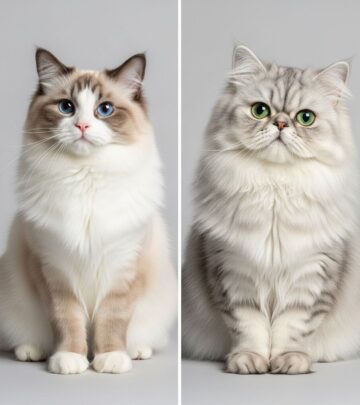Popular Small Bird Species: Your Complete Guide to Petite Pets
Discover the most beloved small bird species perfect for your home and lifestyle

Small birds make wonderful companions for both first-time bird owners and experienced avian enthusiasts. Their manageable size, charming personalities, and relatively straightforward care requirements have made them incredibly popular pets worldwide. Whether you’re drawn to melodious singers, colorful chatterboxes, or affectionate companions, there’s a small bird species perfectly suited to your lifestyle and preferences.
Understanding the unique characteristics, care needs, and personality traits of different small bird species is essential before bringing one into your home. Each species offers distinct advantages and challenges, from varying noise levels to different social requirements. This comprehensive guide explores the most popular small bird species, helping you make an informed decision about which feathered friend might be right for you.
Canaries: The Melodious Songsters
Canaries have captivated bird lovers for centuries with their exceptional singing abilities and vibrant plumage. Originally from the Canary Islands, these small finches were introduced to Europe in the 16th century and have since become one of the most recognized pet bird species globally. Their reputation as talented vocalists is well-deserved, as male canaries produce complex, beautiful songs that can fill a room with delightful melodies.
These birds typically live between 5 to 10 years with proper care, though some individuals may reach even longer lifespans in optimal conditions. Canaries come in an impressive array of colors and patterns, from classic yellow to white, orange, and even variegated combinations. Different breeds have been developed over generations, each with unique song patterns and physical characteristics.
Diet and Nutrition
Canaries thrive on a balanced diet consisting of high-quality seeds, grains, fresh fruits, and vegetables. A seed-only diet is insufficient and can lead to nutritional deficiencies. Dark leafy greens, carrots, apples, and berries make excellent additions to their daily meals. Providing a calcium source such as cuttlebone or crushed eggshells is crucial for maintaining strong bones and overall health, particularly for breeding females.
Housing Requirements
Despite their small size, canaries are active birds that require spacious cages to accommodate their energetic nature. A horizontal cage measuring at least 24 inches long is recommended, as canaries prefer flying horizontally rather than climbing vertically. Multiple perches of varying diameters should be placed at different heights to encourage exercise and foot health. Include some toys and safe branches to provide mental stimulation, though canaries are generally less destructive than parrots.
One distinctive characteristic of canaries is their relatively solitary nature compared to other small birds. Male canaries, in particular, can be territorial and may become aggressive toward other males, especially during breeding season. Many canary owners successfully keep single birds, which often encourages males to sing more frequently as they establish their territory through song.
Finches: Social Charmers in Miniature
Finches represent a diverse group of small, social birds that bring energy and activity to any home. Among the most popular species are zebra finches and society finches, both known for their gregarious nature and delightful chirping sounds. These tiny birds rarely exceed 4 to 5 inches in length, making them ideal for those with limited space who still want to enjoy the company of multiple birds.
Zebra finches are particularly recognizable with their distinctive cheek patches and zebra-striped throats in males. They produce soft beeping sounds rather than elaborate songs, earning them the nickname “beeper birds” among enthusiasts. Society finches, also called Bengalese finches, are entirely domesticated birds that don’t exist in the wild, having been developed through selective breeding in Asia.
Social Dynamics
Finches are highly social creatures that absolutely thrive when kept in pairs or small groups. A solitary finch can become stressed, depressed, and may develop behavioral problems. Keeping at least two finches together ensures they have companionship for preening, playing, and communicating. Many finch owners maintain small flocks of four to six birds, creating a dynamic and entertaining environment.
Care Essentials
Finches require a diet rich in small seeds, millets, and commercial finch pellets. Fresh vegetables and occasional treats like egg food provide additional nutrition. Unlike larger parrots, finches don’t typically enjoy being handled and prefer to be observed rather than directly interacted with. They’re perfect for people who want the joy of bird ownership without the intensive handling requirements of larger species.
Their cage should emphasize horizontal space over height, with multiple perches and some flight space. Finches love bathing, so providing a shallow dish of water for daily baths keeps them healthy and entertained. With lifespans ranging from 5 to 10 years, these cheerful little birds offer years of visual and auditory enjoyment.
Parakeets (Budgerigars): Small Parrots with Big Personalities
Parakeets, commonly known as budgerigars or “budgies,” rank among the most popular pet birds worldwide. These small members of the parrot family pack tremendous personality into their compact 7-inch frames. Native to Australia, budgies have been domesticated for over 150 years and are now available in a stunning variety of colors including blue, green, yellow, white, and numerous combinations.
What makes parakeets particularly appealing is their remarkable intelligence and ability to mimic human speech. While they physically cannot scream like larger parrots, they’re quite vocal and can develop impressive vocabularies with patient training. Some talented budgies have been documented learning hundreds of words and short phrases, making them one of the most accomplished talking birds relative to their size.
Personality and Temperament
Parakeets are naturally curious, playful, and social birds. They form strong bonds with their owners and enjoy interactive play sessions. A well-socialized parakeet will readily step onto your finger, enjoy head scratches, and may even snuggle against your neck. Their friendly disposition makes them excellent choices for families with children, provided the children are taught proper handling techniques.
These birds can be kept alone or in pairs, though single parakeets often bond more closely with their human companions. When keeping multiple budgies, ensure you provide adequate space and resources to prevent territorial disputes. Males and females both make wonderful pets, with males generally being more inclined toward talking.
Living Requirements
A parakeet’s cage should be large enough to allow for short flights, with minimum dimensions of 18x18x18 inches for a single bird. Provide various perches, mirrors, bells, and swings to keep them mentally stimulated. Parakeets are active birds that need daily out-of-cage time in a bird-safe room for exercise and bonding.
Their diet should include high-quality pellets supplemented with seeds, fresh vegetables, and occasional fruits. Avoid feeding avocado, chocolate, caffeine, and salt, which are toxic to birds. Fresh water should be available at all times. With proper care, parakeets typically live 7 to 15 years, with some exceptional individuals reaching 20 years.
Cockatiels: The Gentle Giants of Small Birds
Cockatiels occupy a special place among small bird species as one of the most affectionate and personable options available. These Australian natives are slightly larger than parakeets, measuring approximately 12 to 13 inches including their distinctive crested heads and long tail feathers. Their gentle nature and relatively quiet demeanor make them ideal for apartment living and families seeking a more substantial bird without the intense demands of larger parrots.
The classic grey cockatiel with orange cheek patches and yellow crest is instantly recognizable, but selective breeding has produced 22 different color mutations including lutino (yellow), pearl, cinnamon, and pied varieties. This diversity allows potential owners to choose a bird that matches their aesthetic preferences while enjoying the species’ wonderful personality traits.
Behavioral Characteristics
Cockatiels are renowned for their friendly, even-tempered dispositions. They readily bond with their owners and enjoy physical affection including head scratches, shoulder time, and gentle handling. While they can vocalize and whistle melodiously, they lack the piercing screams of larger parrots, making them considerably more neighbor-friendly.
Male cockatiels are typically more vocal than females and may learn to whistle tunes or mimic household sounds. Some individuals develop limited talking ability, though they’re better known for their whistling prowess. Females tend to be quieter and may be less inclined to vocalize extensively, making them suitable for those preferring a more subdued companion.
Nutritional Needs
Wild cockatiels feed primarily on cultivated crops and native seeds, but pet cockatiels require a more balanced diet than the seed-heavy mixtures often sold commercially. Seeds should comprise only a portion of their diet, supplemented heavily with fresh vegetables like leafy greens, carrots, and bell peppers. High-quality pellets provide essential nutrients that seeds alone cannot offer. Obesity is a common problem in captive cockatiels fed excessive seeds, so monitoring portion sizes and offering plenty of exercise opportunities is crucial.
Cockatiels typically live 15 to 25 years with excellent care, making them a long-term commitment. Their combination of manageable size, affectionate nature, and moderate noise levels has converted countless people into lifelong parrot enthusiasts.
Lovebirds: Affectionate Pocket Parrots
Lovebirds are small, stocky parrots native to Africa that have earned their charming name through their notably affectionate behavior toward their mates and human companions. Measuring just 5 to 7 inches in length, these colorful birds pack enormous personality into their tiny frames. They’re available in numerous color variations including peach-faced, Fischer’s, and masked lovebirds, with plumage ranging from vibrant greens and yellows to blues and whites.
The distinctive eye rings found on most lovebird species add to their expressive appearance, giving them an alert, intelligent look that matches their sharp minds. These birds are highly social and form intensely close bonds with their chosen companions, whether avian or human. In the wild, lovebirds are rarely seen alone, instead traveling in small flocks and maintaining constant physical contact with their mates.
Social Requirements
Lovebirds do best when kept in pairs, as their strong bonding instincts make solitary life stressful. A pair of lovebirds will spend hours preening each other, cuddling, and chirping back and forth in apparent conversation. However, bonded pairs may be less interested in human interaction than single birds raised with extensive human contact. Single lovebirds require several hours of daily attention from their owners to remain emotionally healthy.
These birds are quite vocal, producing constant chirps, whistles, and chattering throughout the day. While they can learn to mimic some sounds, they’re not known for talking ability like larger parrots or even parakeets. Their vocalizations, while not particularly loud, are persistent, so they’re not recommended for those seeking quiet pets.
Activity and Enrichment
Lovebirds are exceptionally active and curious birds that require spacious cages despite their small size. They love climbing, swinging, and exploring their environment with characteristic parrot inquisitiveness. Providing a variety of toys, shredding materials, and foraging opportunities keeps them mentally stimulated and prevents boredom-related behavioral problems.
These little parrots can be feisty and may display territorial behavior, especially during breeding season. Proper socialization from a young age helps ensure they remain friendly and handleable. With lifespans of 10 to 15 years, lovebirds offer over a decade of companionship to dedicated owners willing to meet their social and environmental needs.
Parrotlets: Big Attitudes in Tiny Packages
Parrotlets are the smallest members of the parrot family commonly kept as pets, rarely exceeding 5 inches in length. Despite their diminutive size, these birds possess bold, confident personalities that often surprise first-time owners. Their scientific name, Forpus, comes from the Latin word for “brave,” which perfectly describes their fearless approach to life.
Native to Central and South America, parrotlets are available in several species, with Pacific and Green-rumped parrotlets being most common in the pet trade. Color mutations include blue, lutino, and albino varieties, though the natural green coloration remains most prevalent. Their oversized beaks relative to their body size give them a distinctively parrot-like appearance despite their tiny stature.
Intelligence and Training
Parrotlets are remarkably intelligent and can be trained to perform tricks, step up on command, and even learn some simple words or phrases. Their cognitive abilities rival those of much larger parrots, making them engaging companions for people who enjoy working with their birds. They respond well to positive reinforcement training and can develop impressive behavioral repertoires with consistent practice.
These birds can be quite territorial and may show aggression toward other birds or even their owners if not properly socialized. Single parrotlets bonded closely to their humans often make the best pets, as pairs may become more interested in each other than in people. Early and consistent handling helps ensure a friendly, well-adjusted bird.
Care Considerations
Despite their size, parrotlets need surprisingly large cages to accommodate their active lifestyles. They’re constantly in motion, climbing, playing, and investigating everything in their environment. Multiple toys should be rotated regularly to prevent boredom, and daily out-of-cage time is essential for their physical and mental wellbeing.
Parrotlets are relatively quiet compared to larger parrots, producing chirps and chatter rather than screams. However, they can be persistently vocal, especially when seeking attention. Their diet should consist of high-quality pellets, fresh vegetables, and limited seeds. With proper care, these tiny parrots can live 10 to 20 years, providing many years of spirited companionship.
Choosing the Right Small Bird for Your Lifestyle
Selecting the perfect small bird requires honest assessment of your lifestyle, living situation, and expectations. Each species offers unique advantages and presents different challenges. Consider your daily schedule and how much time you can dedicate to bird care, socialization, and out-of-cage interaction. Some birds, like finches, thrive with minimal handling, while others, like parakeets and cockatiels, require extensive daily interaction to remain tame and bonded.
Noise tolerance is another crucial factor. While small birds generally don’t produce the ear-splitting screams of large parrots, many species are persistently vocal throughout daylight hours. Canaries and finches offer pleasant background sounds, while lovebirds and parrotlets maintain near-constant chatter. If you work from home or have noise-sensitive family members, choosing a quieter species prevents future frustration.
Space and Housing
Evaluate your available space carefully. Even small birds need appropriately sized cages that allow for natural behaviors like flying or climbing. If you live in a compact apartment, finches or canaries might be more suitable than the larger cockatiels. Remember that cages should be placed away from drafts, direct sunlight, and kitchen fumes, which limits placement options in smaller homes.
Long-term Commitment
Consider the lifespan of different species. While finches and canaries typically live 5 to 10 years, cockatiels can easily reach 20 years, and some individuals live even longer. This represents a significant commitment of time, money, and emotional energy. Ensure you’re prepared for the long-term responsibility before bringing any bird home.
Financial considerations extend beyond the initial purchase price. Quality cages, toys, veterinary care, and proper nutrition represent ongoing expenses throughout your bird’s life. Avian veterinarians may be scarce in some areas and typically charge more than small animal vets, so research local resources before committing.
Frequently Asked Questions
Q: Can small birds be kept alone or do they need companions?
A: This depends entirely on the species. Finches and lovebirds are highly social and do best in pairs or groups, as solitary life causes them significant stress. Canaries, particularly males, often prefer living alone and may become territorial with cage mates. Parakeets, cockatiels, and parrotlets can thrive either alone or in pairs, though single birds typically bond more closely with human companions and require more daily interaction to prevent loneliness.
Q: How much daily interaction do small birds need?
A: Interaction requirements vary significantly by species. Finches need minimal direct handling but enjoy visual stimulation from their owners’ presence. Parakeets, cockatiels, lovebirds, and parrotlets require several hours of attention daily, including out-of-cage time, training sessions, and social interaction. Single birds need more attention than pairs. Neglecting a social species’ interaction needs can lead to behavioral problems including feather plucking, aggression, and excessive vocalization.
Q: What are the quietest small bird species?
A: Female canaries are among the quietest options, producing only soft chirps rather than the elaborate songs of males. Finches create gentle beeping sounds that most people find pleasant rather than disruptive. While no bird is completely silent, these species produce significantly less noise than chatty parakeets, persistent lovebirds, or vocal parrotlets. Cockatiels fall somewhere in the middle, capable of whistling and calling but lacking the screaming ability of larger parrots.
Q: Do small birds make good pets for children?
A: This depends on the child’s age, maturity level, and the specific bird species. Parakeets and cockatiels can be excellent for responsible children over age 8 who understand gentle handling and can follow care routines. These species tolerate handling well when properly socialized. Finches and canaries make better “observation pets” for younger children, as they don’t enjoy handling. Parrotlets, despite their size, can be nippy and territorial, making them less ideal for children. Adult supervision is essential regardless of species.
Q: How much does it cost to properly care for a small bird?
A: Initial setup costs include a quality cage ($50-$200), perches and toys ($30-$50), and the bird itself ($20-$300 depending on species and source). Monthly ongoing costs include food ($15-$30), fresh produce ($10-$20), and replacement toys ($10-$20). Annual veterinary checkups typically cost $50-$150, with emergency visits potentially reaching several hundred dollars. Over a bird’s lifetime, expect to invest several thousand dollars in proper care, making them more expensive than many people initially anticipate.
References
Read full bio of Sneha Tete












